|
|
|
|
Products mentioned in this Article
--None--
|
|
|
|
|
|
|
|
|
 |
|
|
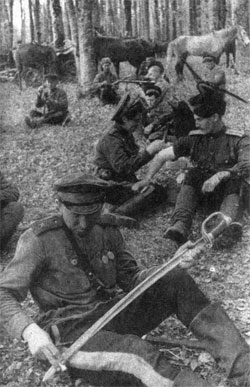 |
V. The Juggernaut Strikes – A Day-by-Day Account
By Wolf Höpper
V.4. 22 November
Return to 21 November...
When the German XI Army Corps realised that its rear area was threatened and the danger of being cut off was imminent, the commanding officer ordered the 376. and 44. Infanterie divisions to retreat to new defensive positions at Blinoye Peresopka and Verchna-Golubaya. The 376. Infanteriedivision was ordered to move further south, during the next day, and establish a planned defensive line behind Golubinskaya. Kampfgruppe Simons, Lepper and the remnants of the Romanian 1st Cavalry Division were ordered to retreat and take up positions next to the German infantry.
At dawn on 22 November the Soviet 6th Guards Cavalry Division and 32nd Cavalry Division of the 3rd Guards Cavalry Corps reached the area of Evlampievskiy and Bolshenabatovskiy.
|
Their reconnaissance forces probed these locations and discovered they were heavily defended by the Germans. About three battalions of the 24. Panzer and 16. Panzer divisions with about 70 panzers were stationed there. The Soviets left this island of resistance as it was, and passed towards the southern and northern edge of Malo-Golubinskiy. Here they were stopped by reserve units of the 16. Panzerdivision blocking the passage to Lucanskij.
|
During the morning hours, the vital armoured cars of Panzer Aufklärungs Abteilung 24 arrived with the rest of Kampfgruppe Don. After conducting some reconnaissance missions with them, the 24. Panzerdivision drew the following conclusions about the overall situation:
The Soviets had expanded their breakthrough and were continuously advancing. The 14. Panzerdivision was still holding a relatively secure position northeast of Verkhna Businovka. The 14. Panzerdivision was mainly being attacked by cavalry forces from the 3rd Guards Cavalry Corps of the Soviet 21st Army.
|
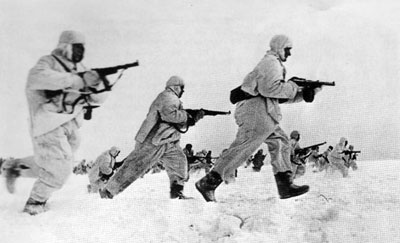 |
|
The Soviet 5th Tank Army was attacking southwards of that position.
The 6th Army command initially intended to set-up a defensive line from Yesseyev to Dobrinskiy, but didn’t have any real combat formations to carry out the plan, as nearly every unit was tied up in Stalingrad or near it. One of the first alarm units to be called upon was a bakery company equipped with infantry weapons from the Army’s stocks and sent to Mayorov to defend the village.
During the night before 22 November the Soviet deputy commander of the Stalingrad Front ordered the 61st Cavalry Division (4th Cavalry Corps) to move into the rear of the 4th Romanian Infantry Division and dislodge them from their defensive positions at Tundutovo, Sadovo and Obilno. The Romanians stubbornly fought against the attack of the 91st Rifle Division, which didn’t make any considerable progress in that sector. For the mission a battery of the 149th Tank Destroyer Artillery Regiment, a Guards Motorised Brigade and three armoured cars were assigned.
|
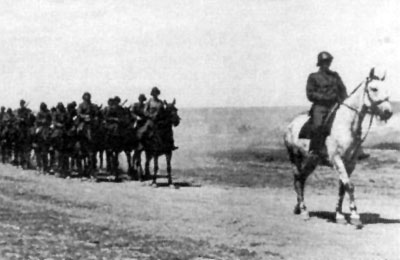 |
The Soviets succeeded with an attack at another point. On the morning of 22 November, Panzer Company Wohlleben discovered that the vital heights near Abganerovo had again been seized by Soviet troops. The Soviets attack out of that assembly area towards Abganerovo and Abganerovo Train Station. Company Wohlleben couldn’t participate in the fighting there, since they first had to fight off Soviet infantry arriving on trucks. The vital town of Abganerovo and its railway station were therefore lost. The Romanian 6th Cavalry Regiment was forced to retreat.
|
A planned counterattack by Kampfgruppe Sauvant was aborted, since the Soviets had dug-in large numbers of their famous 7.62cm “Ratsch-Bumm” (ZIS-3) all-purpose guns. The fighting for Abganerovo and Abganerovo Station cost the Soviets only minimal losses of 27 killed and 34 wounded. This compared to about 300 killed and 600 taken prisoner for the Romanians.
The Soviet victory was only possible because the German 29. Infanteriedivision (motorised) was ordered to retreat the day before. The order from Army Group B stated that the division was to establish a defensive perimeter around the Rokotino area, to keep the Soviets from advancing into the rear of Stalingrad. This order was a miscalculated evaluation of the actual events happening on the ground. The Soviets never intended to directly link with their beleaguered comrades in the city, like the German officers assumed. It turned out to be a major strategic error.
|
|
The Soviet battlegroup left Abganerovo at 0800 hours and advanced towards Kurgan Solianoye and Umantsevo, where they battled elements of the 8th Romanian Cavalry Division. The Romanians put up a strong defensive fight and held Umantsevo until 24 November. The Soviet advance was stopped at this point.
Kampfgruppe Don (24. Panzerdivision) was ordered to capture the line between Businovka-Businovka – Yerik and start reconnaissance activities until the rest of XIV Panzer Corps arrived.
The 24. Panzerdivision planned to attack with its two panzer battalions from Suchanovskiy north towards Businovka.
|
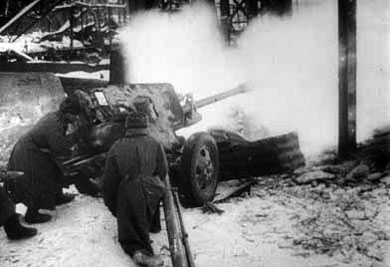 |
|
It did so and ran into units of the Soviet 5th
Tank Army. Other units met enemy advances and the 24. Panzerdivision
transmitted via radio that they had encountered advancing cavalry and
tank units. A link to the 14. Panzerdivision could not be established,
since Businovka was already enemy controlled.
At 0800 hours the Soviet 112th Cavalry Division, accompanied by the staff of 8th Cavalry Corps, moved towards Krasnoyarovka and Arzhanovskiy. They intended to cut off the retreating elements of 5th Romanian Army Corps, Romanian 1st Armoured Division and German 22. Panzerdivision.
After the 23rd and 28th Guards Cavalry Regiments, of 3rd Guards Cavalry Corps, deployed for their attack, the 25th Guard Cavalry Regiment was put behind them in reserve. The cavalry rode into battle on their horses, sabres drawn, until they were shelled by mortar and machine gun fire. After they dismounted, the attack continued, but was considerably slower.
|
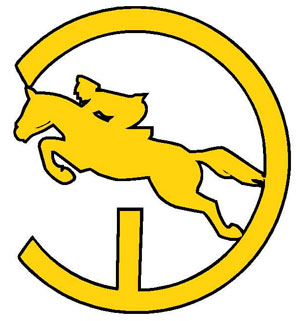 |
Around 0800 hours the Soviets penetrated the first line of defence around the State Farm and quickly cleared the town of any resistance. The Germans lost about 200 soldiers.
The rear echelons of 55th and 112th Cavalry Divisions were attacked at 0930 hours by German and Romanian motorized units (including 20 panzers). The attack column was discovered by the 8th Cavalry Corps at 0830 hours.
The independent anti-tank battalion, the training battalion and the artillery of 55th Cavalry Division set up a defensive perimeter and, together with 35th Guards Motorised Regiment, repelled the attack. The German 22. Panzerdivision lost a number of panzers and trucks and withdrew south. For the first time, the German air support was really felt. The German attack was supported by Ju-87 Stukas of General Leutnant Fiebigs 8th Flieger Corps.
The main Soviet forces continued their exploitation advance. Enemy tanks and motorized infantry of the Romanian 1st Armoured Division were reported by 55th Cavalry Division approaching from the east and southeast.
|
After 1000 hours, the corps commander of 26th Tank Corps, Rodin, decided to take Kalach by night. He ordered Lieutenant Colonel Filippov, commander of 14th Motorised Rifle Brigade to take Kalach in a lightning blow during the night.
While this decisive action was undertaken, the rest of the corps came under attack around Collective Farm Pobeda Oktyabr. Here some elements of the 24. Panzerdivision, assisted by ad-hoc combat groups of stragglers, set up a cohesive defensive line during 21 November. The 26th Tank Corps was not able to break this resistance.
|
|
The XIV Panzer Corps ordered the 16. Panzerdivision, in conjunction with elements of the 24. Panzerdivision, to attack northwest of Mostovskiy towards Tsvorin and eliminate the enemy forces there. After that a turn south or north was at the division’s discretion, according to situational circumstances. This attack, if successful would definitely cut off the most forward Soviet units, the 26th and 4th Tank Corps. Unfortunately the division was still assembling and the attack was aborted. Any further thoughts of attack seemed unlikely as parts of the division were already defending east and west of the Golubaya sector. The panzer regiment, as the first arriving combat unit of that division, nonetheless attacked in the dense fog towards Suchanov, but was stopped by excellently camouflaged Soviet infantry of the 5th Ski Brigade. These troops were well equipped with anti-tank weapons. This together with the ever-present fuel shortage forced the division to retreat. Another problem to hamper the attack was the near complete lack of signal units. Motorcycle riders had to carry the messages and orders between the different parts of the division.
The Soviet 159th Rifle Division, on the 5th Tank Army’s right flank, captured Kamenka and advanced toward Bokovskaya.
|
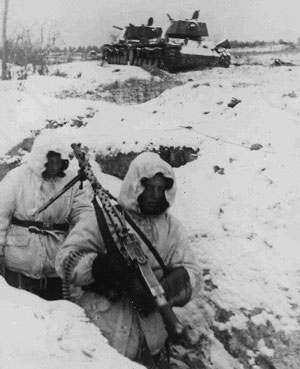 |
The 21st Cavalry Division (8th Cavalry Corps) followed retreating enemy units and turned towards Verkhna-Maksay, and later southwards. The plan of the corps commander was to attack towards Chernyshevskaya and join with the rest of the corps, since the previous engagements had separated the division from the main body. The 119th Rifle Division captured Korotkovskiy and prepared to attack Zhirki.
Around 1300 hours the 47th Guards Rifle Division (5th Tank Army) debouched on the Chir River, captured Demin and Chernyshevskaya and finally eliminates the enemy resistance in front of their lines. A further advance was stopped by a hastily assembled combat group, Kampfgruppe Wantke, consisting of soldiers returning from leave, converted rear area soldiers, and assembled parts of the retreating Romanian 1st Armoured Division.
|
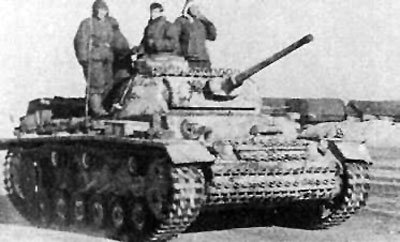 |
During the morning the Soviet 8th Motorcycle Regiment and an assigned tank company attack Oblivskaya, a minor airfield. They were repulsed and could not clear the objective of German resistance. The regiment was moved to Perelazovskiy, which it completed by evening.
The 14. Panzerdivision retreated to Verchnaya-Golubaya. During the withdrawal, panzers that had been immobilized during the fighting had to be destroyed due to a lack of proper recovery services.
|
|
The 5th Tank Army command realised the threat to
its exposed mechanised formations because the covering rifle divisions
were still held back fighting Romanian infantry units. However the 5th
Tank Army ordered a further advance of its tank corps. The intention
was to counter any probable enemy reserve movement and advance further
southwest towards Kalach.
During the night and the whole next day, the tank corps advanced in a classic blitzkrieg fashion: Drive onwards to your goal without engaging the enemy, so they are constantly unbalanced.
During the day the connection between the 24. Panzerdivision and the XI Army Corps at Ossinovskiy was severed by advancing Soviet cavalry. The last order 24. Panzerdivision received from the corps was to use the newly arriving grenadier regiment to close the gap with the 14. Panzerdivision. The grenadiers never arrived. Despite this the 24. Panzerdivision launched its counter-attack.
|
|
At the heights of Suchano, to the west and southwest, the panzerjägers and FlaK took up defensive positions to guard the flanks of the attacking panzer battalion. Although Businovka was defended by Soviet cavalry, and another unit that was advancing west of the village, both panzer battalions made good progress and partially routed them. During that attack the situation changed. West of Yerusslanovskiy a strong tank brigade of 26th Tank Corps advanced, accompanied by motorised infantry, through the Bystrik-Yerik valley.
The bakery company stationed at Mayorov was no
match for this force and was almost instantly annihilated.
|
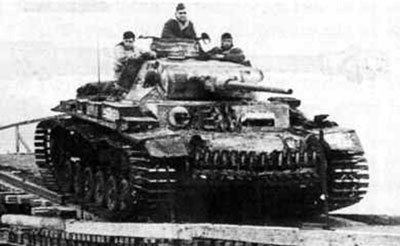 |
|
The
advancing Soviets split their forces. The weaker force advanced towards
Suchano, but the main force advanced towards Yerusslanovskiy.
Another unnoticed group moved south of Katshalinskaya towards Kalach. This was the assault group that would take the bridge and seal the fate of 6th Army.
The panzer attack towards Businovka was stopped and redirected to take Yerusslanovskiy. The panzers seized the village and engaged enemy forces in a deadly tank duel. The few panzers managed to repulse the Soviets, but could not advance, since they lacked trained infantry support. Only small groups of retreating Romanians, supply units, and scattered security forces were available.
|
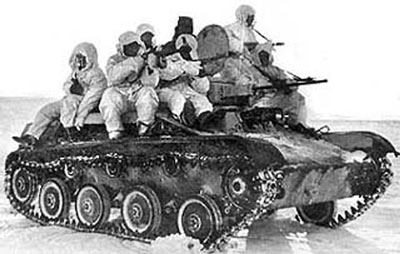 |
While the enemy was held here, Soviet infantry and dismounted cavalry, with tank support, attack Suchanov from the north.
The German kampfgruppe was bypassed on both flanks, as mobile enemy forces crossed the Liska sector and take Ossinovskiy and Lipologovskiy. Because their own casualties were mounting, the 24. Panzerdivision withdrew its units from the advantageous positions. The timely arrival of the rest of XIV Panzer Corps, especially the 16. Panzerdivision, was unlikely and Army headquarters denied a request for reinforcements.
|
|
During the night the retreat was, despite biting wind, freezing
temperatures and strong snow falls, executed in an orderly and
organised manner. After the majority of its combat units crossed the
small bridge at Suchano, the 16. Panzerdivision’s staff also retreated
under protection of the panzers.
The 376. Infanteriedivision, down to 4,200 soldiers, was ordered to retreat in a southeastern direction and crossed the Don two days later at Vertiyatshi. On their way back they were able to acquire some panzers from a repair facility at Peskovatka.
Attacks against the front of the German IV Army Corps were mainly repulsed and only a small bulge in the 76. Infanteriedivision’s line was achieved. The Soviet 24th Army tried to dislodge this sector, to hamper the German retreat, and to keep the advancing mobile units supported. The attacks lacked the fierceness and necessary supplies and German front held.
|
At 1700 hours the 112th Cavalry Division arrived at Krasnoyarovka, where they set up defensive positions running from northeast to east along the Chir River bank. At midnight, the retreating German and Romanian units tried to break through to their own lines, but were repulsed and retreated towards Russkaya Sloboda and Petrovka. After the action, the 35th Guards Motorised Regiment, 179th Anti-tank Artillery Regiment and 511th Tank Flamethrower battalion were detached from 8th Cavalry Corps and put into the reserve of 5th Tank Army. The 174th Anti-tank Artillery Regiment missed most of the action due to lack of fuel.
|
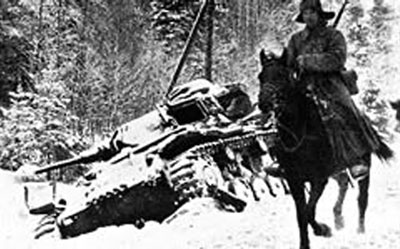 |
To finally destroy the cut off enemy units, the 55th Cavalry Division was ordered to attack them from behind. The 112th Cavalry Division was ordered to attack from their recently gained positions. This action was scheduled for the next day. The German 76. Infanteriedivision was directly assaulted by the 26th Tank Corps. The Soviets were headed for Vertiyatshi. The German 76. Infanteriedivision held their positions until 28 November when they were also forced to retreat.
At 2100 hours Soviet tank and cavalry forces attacked the 24. Panzerdivision in strong numbers, bypassing them in the south, and capturing the area thinly held by the various alarm groups. A new defensive line was established at the Rossotich sector. At the same time, the supply and medical units of the panzer battalions were taking up arms and establish a defensive perimeter in and around Sveciy Krassniy. One of the retreating panzer companies was encircled at Yerusslanovskiy, but fought its way out eastwards, inflicting heavy casualties on their attackers.
|
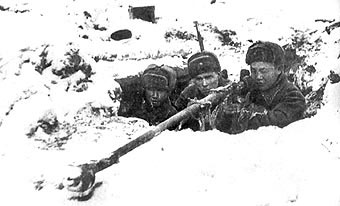 |
At 2200 hours the Soviets attacked the little village of Gontsharovskiy, south of Abganerovo with strong infantry forces from the 302nd Rifle Division. Kampfgruppe Sauvant supported the Romanian infantry defending and the assault was held off until midnight.
On the right wing of the 6th Guards Cavalry Division, the 32nd Cavalry Division (3rd Guards Cavalry Corps) attacked at midnight towards Bolshenabatovskiy and encircled it from the northeast. The 6th Guards Cavalry Division regrouped and attacked towards Luchenskiy and Kalachkin. The 5th Guards Cavalry Division moved during the night, and destroyed a number of retreating enemy units.
|
At midnight the forces surrounded east of Verkhna-Fomikhinskij break out of Shirk and reach the lines of the German 22. Panzerdivision south of Bolshaya Donshchinka. Here they joined forces for a counter-attack against the Soviet bridgehead at the Chir River. The 5th Tank Army reacted quickly and ordered the 346th Rifle Division and 8th Guards Tank Brigade to night march. It was intended to counterattack this threat the next day.
During the day panzers from the XIV Panzer Corps repair workshop at Kotelnikova arrive at Akssay. Major Sauvant raised another panzer company with 10 panzers under the command of Oberleutnant Schmid. The required staff and signals vehicles also arrived. Kampfgruppe Sauvant now had two weak panzer companies (18 panzers), one infantry company and a reserve company (consisting of various supply and rear area units).
|
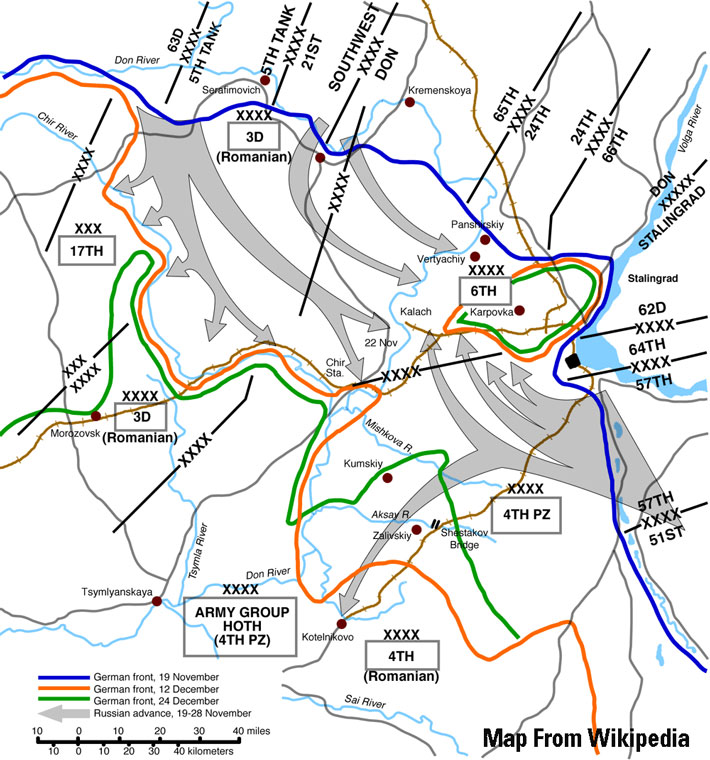 |
By the end of the day the Soviet 1st Tank Corps reached Tuzov and Zrianinskiy. From there reconnaissance forces were sent towards Surovikino and Rychkovskiy. The tank corps was also free to exploit the breakthrough. The 26th Tank Corps reached the Don area near Kalach.
Results of the Forth day
The events of the 22 November continue on from the previous day:
The Germans desperately tried to counterattack the advancing Soviet tank and cavalry formations, but were repulsed and forced to retreat. The only positive aspect was that the retreat of the XI Army Corps was executed very well and most of the equipment saved. Even the pursuing attacks of the Soviets were repulsed. The German northern lines remained intact and even held against the Soviet attacks during the cauldron phase of the battle. Later in February the XI Corps contains the last German soldiers to surrender at Stalingrad.
|
Elsewhere the overall situation was bad:
In the southern Soviet attack area the advancing forces were resuming their movements and marched unhindered towards the vital bridge at Kalach. The German 29. Infanteriedivision (motorised) and the Romanian 20th Infantry Division were forced to hold their positions, although they would have been able to easily cut off the Soviet mechanized units. Failing that a counterattack would have at least slowed down the Soviet advance. The southern Soviet forces were not as well supplied as their northern counterparts.
General Hoth was forced to move his headquarters to Nishna-Chirskaya. The delay, while new communications were established, prevents Hoth from resuming his staff work for several days. The only good point here was several officers rally the retreating troops at Verkhna-Cirshiy and thereby establish on 24 November Kampfgruppe Abraham. This force played a vital role in supporting the German Operation Wintergewitter, the attempt to relieve the trapped 6th Army.
|
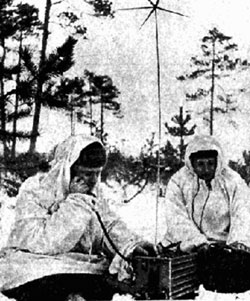 |
The Soviets were now threatening the right wing
of the German ad-hoc army, later named Army Corps Hollidt, which
desperately tried to establish a cohesive defensive line to hold the
Chir River against the Soviets.
Day Five, 23 November (live on 14 January 2010)... |
Last Updated On Wednesday, November 18, 2009 by Wayne at Battlefront
|
|
|